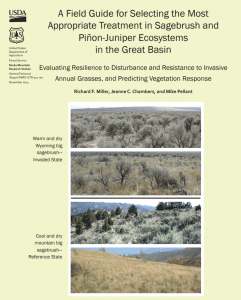Field Guide
View guide.
In this study, researchers modeled the climatic envelope for subspecies wyomingensis for contemporary and future climates (decade 2050). Comparison of the contemporary and decade 2050 models shows a predicted 39% loss of suitable climate. Much of this loss will occur in the Great Basin where impacts from increasing fire frequency and encroaching weeds have been eroding the A. tridentata landscape dominance and ecological functions. The goal of this study is to provide a management tool to promote successful restoration by predicting the geographic areas where climate is suitable for this subspecies.
View field guide.
This field guide identifies seven primary components that largely determine resilience to disturbance, as well as resistance to invasive grasses and plant succession following treatment of areas of concern. An evaluation score sheet is included for rating resilience to disturbance and resistance to invasive annual grasses and the probability of seeding success.
View review.
In this paper, authors review state-of-the-art methods and models that can be used to evaluate ranch-level decisions and land-use policy impacts.
View guide.
This guide provides information about stakeholder groups to assist managers as they deal with issues facing these systems. The guide was created for land managers to consult as they plan and carry out projects, particularly on public land where groups often have conflicting interests.
View guidebook.
This guide provides a set of tools that will help field biologists, land managers, and private landowners conduct rapid qualitative field assessments that address the kind of site and its current state. These tools include a list of questions to be addressed and a series of photographs, keys, tables, and figures to help evaluate a site. Conducting this assessment will help prioritize sites to be treated, select the best treatment, and predict outcomes.
View guide.
This guide was written for anyone interested in learning more about sagebrush species and habitats. It provides descriptions of some of the remarkably diverse sagebrush communities in western North America. It gives identifying characteristics and range maps of 18 species of sagebrush.
View guide.
This guidebook focuses on the use of weather and climate information in the Ecologically-Based Invasive Plant Management Framework in planning and post-management treatment evaluation. It provides land managers with resources for finding weather and climate data, and tools for incorporating this data into adaptive management planning for rangeland restoration.
View guidebook.
This guidebook contains science-based principles, processes, and tools necessary to assist with developing adaptation options for national forest lands. Because management objectives and sensitivity of resources to climate change differ among national forests, appropriate processes and tools for developing adaptation options may also differ. Regardless of specific processes and tools, the following steps are recommended: (1) become aware of basic climate change science and integrate that understanding with knowledge of local resource conditions and issues (review), (2) evaluate sensitivity of specific natural resources to climate change (rank), (3) develop and implement strategic and tactical options for adapting resources to climate change (resolve), and (4) monitor the effectiveness of adaptation options (observe) and adjust management as needed.
View guide.
This guide assimilates post-treatment vegetation and fuels data from Sagebrush Steppe Treatment Evaluation Project (SageSTEP) study sites across six Great Basin states into an assessment tool that can help managers better estimate percent cover, stem density and fuel loadings for post-treatment sites. The post-treatment Guide uses photographs and tables to provide the range of values for each vegetation type allowing users to quickly appraise a site by fuel stratum using an ocular estimate.


